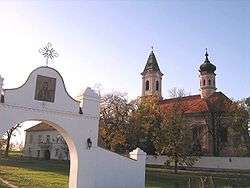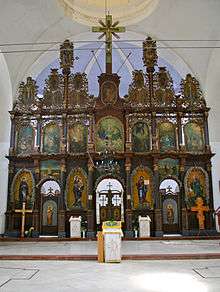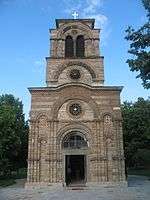Fenek monastery
|
The Monastery | |
| Monastery information | |
|---|---|
| Full name | Манастир Фенек |
| Order | Serbian Orthodox |
| Established | 1450-1499 |
| Diocese | Eparchy of Srem |
| People | |
| Founder(s) | Stefan Branković |
| Important associated figures | Angelina Branković |
| Site | |
| Location | Surčin municipality, Belgrade, Serbia |
Fenek Monastery (Serbian: Манастир Фенек / Manastir Fenek) is the male monastery in the eparchy of Srem of the Serbian Orthodox Church. The monastery is situated near the village of Јаkovo, 25 km from Belgrade, former Municipality of Zemun аnd now Surčin.[1] Although geographically it does not belong to Fruška gora there is a huge historical connection with Fruška gora monasteries. The monastery church was dedicated to St. Martyr Paraskeva (celebrated on 26 July, that is, 8 August according to the new calendar).
The history
According to the folk tradition, the monastery was built in the second half of the 15th century and its founders were Stefan and Аngelina Branković. The first written record[2] about the monastery is found in the minej (a religious book) of the monk Zaharije from 1563. Unlike other Fruška gora monasteries, Fenek remained under the Ottoman government until 1717. The records from the 18th century testify that the old monastery church was built in the second half of the 15th century in the spirit of Serbian medieval architecture. The new church was built in the period from 1793-1797, and consecrated during the time when Vikentije Rakić was the abbot; he also wrote the history of the monastery. The monastery chapel dedicated to St Petka was built in 1800, on the site of the old one, above the well, which was believed to have been built by the mother Angelina Branković. People believed that the water from this well had some healing powers.[3] By the end of the 18th and the beginning of the 19th century, the Fenek Monastery was the venue of the several historical events. In 1788, duke Аleksa Nenadović and Austrian emperor Јоsef II met in the monastery. After the collapse of the First Serbian Uprising in 1813 Karađorđe and his son Aleksa stayed in a monastery for a month. There is a memorial plaque as a testimony. Also on the same occasion, until 1815, monks from Studenica stayed there, along with the relics of St. King Stefan Prvovenčani. The monastery was also the place where Karađorđe met archpriest Маteja. In the First World War the monastery was set on fire, and in the Second World War in 1942 it was almost completely devastated.
The Architecture
The monastery complex consists of the church, the chapel, the mansion and the economic part. The church, built in 1797 and dedicated to St. Petka dominates the complex. The church was built as a one-nave Baroque building with the bell tower above the western part and the smaller dome above the transept. The iconostasis[4] inside the church from 1798 was the work of the famous woodcutter from Novi Sad, Аksentije Marković .[5] The icons are the work of Petar Radosavljević, a painter from Pančevo, with characteristic elements of classicism. The frescoes on the walls, the work of a Zemun painter Dimitrije Petrović from 1859, have not been saved up to now. The mansion which are placed inside the monastery complex date back from the late 18th and early 19th century. According to the archive records they were built long before that, but were demolished over the time and used for the construction of the new ones. The rich library, which was known as one of the most important Fruška gora monastery, was situated in the mansion, but during the First World War it was completely destroyed. The records of doctor Archibald Reiss testify about that event.[6] In the immediate vicinity of the church, there is a monastery chapel dedicated to St. Petka. It was built above the well, which was believed to have been built by mother Angelina Branković. People believed that the water from this well had miraculous healing power.
„The Golden Cross”
The milestone, also known as „The Golden Cross“ proves the large size of the monastery property. It is placed on the right side of the road connecting Jakovo and Bojevce, about 400 m after the Fenek monastery turning. On 20 January 1743 the Empress Maria Theresa assigned „the privilege“ to the Fenek monastery, according to which the property was granted to the monastery. Immediately after that, the bounding of the monastery property was done. The milestone was erected in 1747, thanks to Nikola Marković, and it got the name after the folk tradition, according to which the Serbs rushed to get hold of this milestone, since they felt safe on the monastery property. That is why the monument bears the name Golden cross – as the symbol of salvation.
The Cultural Monument
Within the property of the Fenek monastery and its protected environment there are several archaeological sites: Fenek Mnastery (Middle Ages), Monastery Prnjavor (late Middle Ages) and Monastery fields (Neolithic). The monastery was reconstructed in 1991, and nowadays it is completely renewed. Until 2006, three older nuns lived in the monastery, one of them, sister Agripina died, and the remaining two were moved to other monasteries, mother Paraskeva to the monastery Greteg and Abbotess Magdalina to Radovašnica. By the decision of the competent archimandrites of Srem Vasilije and Of Raška and Prizren Аrtemije the new male monkhood arrived to the monastery in the middle of 2006, Marko from Sopoćani and Makarije from Dečani. Since then, the visits to the monastery increased and the reconstruction of the mansion is in progress.[7] The patron saint of the monastery is Venerable mother Paraskeva, celebrated on 27 October, the folk gathering and the fair is on 7 August.[8]
See also
References
- ↑ Spomenici kulture u Srbiji: Мanastir Fenek (website SANU)
- ↑ [Lj. Stojanović, The old Serbian records and inscriptions, III The collection for the history, language and literature of Serbian nation SA, I, 1905; V. Petković, The summary of church monuments through the history of Serbian nation, Belgrade, 1950 ]
- ↑ [М. Коsovac, Serbian Orthodox Metropolis of Karlovac, Sremski Karlovci, 1910; D. Ruvarac, The Metropolis of Belgrade around 1735, the Monument SKA XLII, Belgrade 1905]
- ↑ [B. Gavrilović, Some of the woodcarving centres in Vojvodina, The work of Vojvodina museums, Novi Sad, 1954]
- ↑ [The works of the woodcarver Aksentije Marković, The church of St. Peter and Paul in Bela Crkva, the Monastery Beočin, the Monastery Bezdin; he is the author of the first Baroque sculpture in Novi Sad – „The Sacrifice of Noah“ (the bell tower of Almaška church) – the work is not saved; K. Pavlović, One not so famous artist from the First Serbian Uprising, „Politika“, no. 18161 from 26 April 1964. S. Stefanović „From the beggar to the nobleman“, „Blic“18 February 2008]
- ↑ [I. Vesković, The house of doctor Archibald Reiss, The Cultural Heritage Protection Institute of the City of Belgrade ]
- ↑ [The documentation of the Cultural Heritage Protection Institute of the City of Belgrade, according to the Law on Protection of Cultural Properties („The Official Gazette SRS“ no. 28/77) the decision was issued according to which the Fenek Monastery is designated as the cultural property of great importance to the Republic of Serbia (The Decision on designation, „The Official Gazette SRS“ no. 14/79). The immediate vicinity of this monastery, Protected environment around the cultural property of a great importance – Fenek Monastery, enjoys the status of the unity under the previous protection.]
- ↑ Мanastir Fenek, Manastirska slava, retrieved on 12 February 2013.
External links
| Wikimedia Commons has media related to Fenek monastery. |
Coordinates: 44°44′24″N 20°13′28″E / 44.74000°N 20.22444°E


